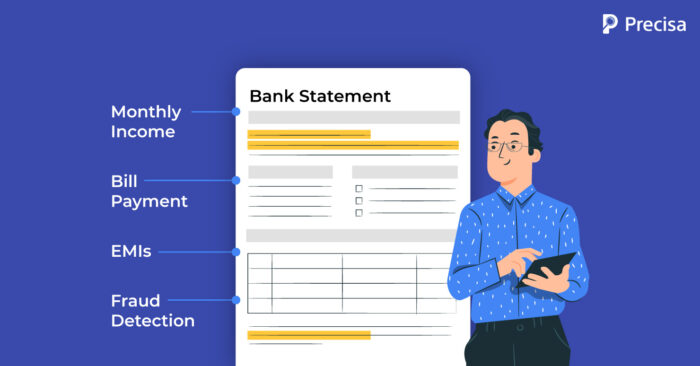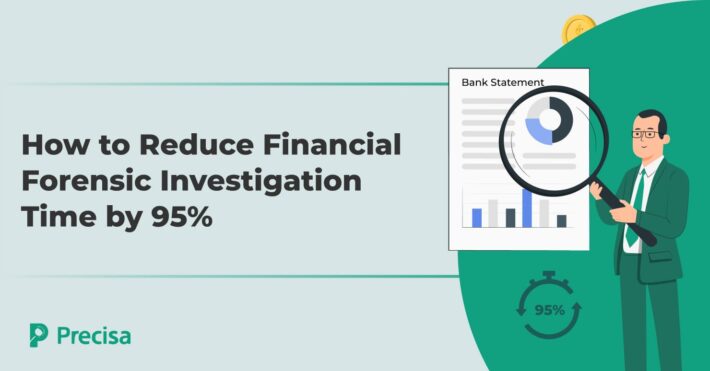8 Important Metrics Bank Statement Analysers Evaluate and Track

Indian banks have written off a whopping $9.9 trillion worth of loans in the last five years, out of which they could recover about $1.84 trillion.
It is also worth noting that around 2,623 wilful defaulters owe around $1.96 trillion to banks in India.
These figures reinforce the need for tighter scrutiny of the borrower’s financial health and stringent background checks to prevent economic slowdown and safeguard the country’s banking sector.
In this case, bank statement analysis can offer lenders precious insights into the borrower’s cash flow expenses, credit history, and creditworthiness. Although these are not the only tools to assess a borrower’s ability to repay loans, they streamline loan approvals and encourage swift and informed decision-making.
This article highlights why lenders must include bank statement analysis during loan approval.
Bank Statement Analysis: An Outline
Bank statement analysis is a critical process used by lenders to gain insights into a borrower’s financial health, spending habits, and creditworthiness by evaluating their bank statements.
This is typically carried out by scanning or uploading bank statements to a bank statement analyser tool. This system leverages the financial data to detect financial patterns and identify red flags like irregular transactions, allowing lenders to make data-driven and accurate credit decisions.
How Does Bank Statement Analysis Help Lenders?

Let’s go over the advantages of bank statement analysis and how it empowers lenders to mitigate risks and enhance loan approvals.
1. Monthly Income
Bank statements provide a clear understanding of the borrower’s spending habits and monthly income, which can be used to determine whether the borrower is capable of repaying the loan.
Most lenders set a minimum income threshold, particularly for personal loans, wherein the higher the income, the lower the risk.
2. Bill Payment
It is important for lenders to know how frequently the borrower pays essential bills, including electricity, credit card, and other recurring expenses.
An analyser tool offers clear insights into a borrower’s financial discipline and whether they are capable of paying bills on time.
3. EMIs
Tracking and monitoring the Equated Monthly Installment (EMI) allows lenders to determine the borrower’s repayment behaviour and debt burden.
A bank statement analyser is a great tool to unlock payment patterns, spot missed or delayed instalments, and pinpoint inconsistencies.
4. Cash Withdrawal and Debit Card Spend
While cash withdrawal, as the name suggests, is the total amount of cash withdrawn from ATMs or banks, debit card spending indicates the number of debit credit transactions made in a stipulated period.
A bank statement analyser digs deep into this information, offering a clear sight of the borrower’s financial behaviour.
5. Fraud Detection
One of the key reasons why the demand for bank statement analysers has increased is the tool’s ability to detect unauthorised transactions, fraud, and other subtle discrepancies.
Early and timely detection of suspicious behaviour may prevent financial losses for borrowers.
6. Categorised Payment History
Thorough and in-depth bank statement analysis allows lenders to bifurcate borrower payments into UPI, cash, payment gateway, credit card, debit card, etc.
This information not only dissects the borrower’s spending habits but also highlights their e-commerce preferences and digital payment behaviour.
7. Expense: Income Ratio
The expense-to-income ratio is another important metric used to determine a borrower’s financial discipline and management.
A debt service of around 35% and housing costs of around 28% of the monthly income is generally considered to be a health expense-to-income ratio.
8. Total Bounces
A bank analyser examines the number of bounces of a borrower to determine whether they are reliable.
Recurring or frequent bounces typically indicate cashflow-related issues or financial barriers; both are huge red flags for lenders while evaluating the borrower’s creditworthiness.
Role of Technology in Bank Statement Analysis
The advent of artificial intelligence (AI) is proving to be a game-changer during bank statement analysis. Let’s go over the role of automation during bank statement analysis and how it benefits lenders:
AI to detect patterns
Bank statement analysis coupled with AI is a welcome relief for lenders who can replace tedious and mundane tasks with automation.
For instance, AI-powered algorithms and different machine learning (ML) systems equip lenders to detect patterns in large transactional data sets.
Cloud Computing
Adopting cloud computing for bank statement analysis allows lenders to migrate applications and data to the cloud, resulting in 20-30% cost savings.
Centralised cloud data enables real-time access and analysis, reduces data silos and inconsistencies, and facilitates integration with third-party applications via APIs.
Cloud platforms also provide enhanced security, compliance, and disaster recovery capabilities.
Advanced Analytics and Insights
Technology-driven bank statement analysis provides lenders with a 360-degree view of a borrower’s financial health, cash flows, and creditworthiness. Customisable dashboards allow underwriters to analyse specific metrics and KPIs
On the other hand, predictive analytics help identify spending patterns, forecast future trends, and develop personalised products.
Fraud Detection and Risk Management
Bank statement analysis software leverages AI and ML to detect suspicious activities, circular transactions, and potential money laundering in line with AML-CFT guidelines.
Parting Words
Gone are the days when bank statement analysis could take weeks and even months. As technology continues to make inroads in the financial ecosystem, sophisticated tools, including bank statement analysers, have garnered immense attention.
These tools offer detailed information about a borrower’s cash flow, as well as other parameters discussed earlier.
Precisa’s bank statement analyser allows lenders to trim processing time by 5x and improve productivity by 8x.
Our tool has processed more than 55 million transactions across 1000+ formats, making it one of the most trusted bank statement analysers in the market.
Schedule a demo to learn more!



